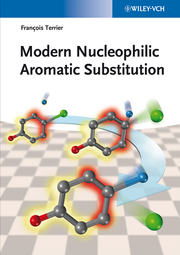-
Zusatztext
-
Providing an updated overview of SNAr substitutions, balancing both mechanistic and synthetic viewpoints, this book gives a comprehensive account of this versatile field. The first chapter deals with a mechanistic analysis of the factors governing the feasibility of SNAr substitutions, providing useful information to predict the regio- and stereoselectivity control of the reactions and to define the conditions for concerted SNAr processes. Reflecting the key role played by these species as intermediates in most SNAr reactions, Chapter 2 then discusses the chemistry of anionic s-complexes. Chapter 3 describes the new concept of superelectrophilicity which has emerged from the kinetic and thermodynamic data collected in the preceding chapters, while the numerous synthetic applications are considered in depth in the chapters that follow on intermolecular, intramolecular, and nucleophilic aromatic substitutions of hydrogen. The final chapter brings together concise yet comprehensive discussions surrounding SNAr photosubstitutions, radical substitutions, and ANRORC substitutions. Authored by an eminently respected chemist who has contributed greatly to the field over the past two decades, this is a valuable information source for all organic chemists working in academia or the pharmaceutical and agrochemical industries.
-
-
Kurztext
-
Nucleophilic Aromatic Substitutions (SNAr) represent a class of reactions of crucial importance in organic synthesis. This book provides a comprehensive overview of this versatile field, focusing on the mechanistic and synthetic features that govern these reactions. The first chapter presents a detailed mechanistic analysis of the factors determining the feasibility of SNAr substitutions, providing decisive information to predict regioselectivity of many reactions and to defi ne the conditions for concerted SNAr processes. Reflecting the key role played by these species as intermediates in most SNAr reactions, Chapter 2 then discusses the chemistry of anionic sigma-complexes. Chapter 3 describes the concept of superelectrophilicity in SNAr substitutions, as it has recently emerged from the reactivity of strongly electron-defi cient aromatic and heteroaromatic structures. The numerous synthetic applications are considered in depth in the Chapters 4 and 5 that follow on intermolecular and intramolecular nucleophilic aromatic substitutions. Then, Chapter 6 focuses on substitutions proceeding formally through displacement of a hydride ion, a hot topic in the field. The final chapter brings together concise yet comprehensive discussions surrounding SNAr photosubstitutions, radical substitutions, and ANRORC substitutions. Each Chapter starts with a short general introduction to the topics discussed. Authored by a highly respected chemist who has contributed greatly to the field over the past two decades, this is a valuable information source for all organic chemists working in academia or the pharmaceutical and agrochemical industries.
-
-
Autorenportrait
- InhaltsangabeTHE SNAr REACTIONS: MECHANISTIC ASPECTS Introduction Activation of the Aromatic System: Driving Force for SNAr Reactions Leaving Group, Nucleophile, Solvent, and Medium Effects Effects of Specific Structural Variations in the Activated Ring Spectral Evidence for the Intermediacy of sigma-Complexes in SNAr Reactions Base Catalysis in SNAr Reactions Regioselectivity in SNAr Reactions Asymmetric SNAr Substitutions Concerted SNAr Substitutions Conclusion STRUCTURE AND REACTIVITY OF ANIONIC SIGMA-COMPLEXES Introduction Structural Features of sigma-Complexes Thermodynamics and Kinetics of sigma-Complex Formation THE SUPERELECTROPHILIC DIMENSION IN SNAr AND RELATED SIGMA-COMPLEXATION PROCESSES Introduction The Classical Domain of SNAr and Anionic sigma-Complexation Reactivity Reaching the Superelectrophilic Dimension The Synthetic Potential of sigma-Complexation and SNAr Reactivity in the Superelectrophilic Dimension Origin of the Superelectrophilicity of Neutral 10pi Heteroaromatics SYNTHETIC ASPECTS OF INTERMOLECULAR SNAr REACTIONS Introduction Intermolecular Displacements of a Nitro Group Intermolecular Displacements of Halogen and Other Leaving Groups Conclusion INTRAMOLECULAR SNAr REACTIONS Introduction SNAr Cyclizations Smiles Rearrangements Conclusion NUCLEOPHILIC AROMATIC SUBSTITUTIONS OF HYDROGEN Introduction Reactions Involving Oxidation of sigma-Complex-Type Intermediates Vicarious Nucleophilic Aromatic Substitutions of Hydrogen (VNS) Deoxygenative SNArH Substitutions Cine and Tele Substitutions Conclusion OTHER SNAr SUBSTITUTION PATHWAYS SN(ANRORC) Substitutions Radical Nucleophilic Aromatic Substitutions Nucleophilic Aromatic Photosubstitutions
Detailansicht
Modern Nucleophilic Aromatic Substitution
ISBN/EAN: 9783527318612
Umbreit-Nr.: 4534634
Sprache:
Englisch
Umfang: 488 S.
Format in cm: 2.9 x 24.8 x 17.9
Einband:
gebundenes Buch
Erschienen am 12.06.2013
Auflage: 1/2013


